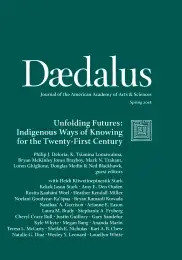Why Don’t More Indians Do Better in School? The Battle between U.S. Schooling & American Indian/Alaska Native Education
American Indian/Alaska Native education – the training for life of children, adolescents, and adults – has been locked in battle for centuries with colonial schooling, which continues to the present day. Settler societies have used schools to “civilize” Indigenous peoples and to train Native peoples in subservience while dispossessing them of land. Schools are the battlegrounds of American Indian education in which epistemologies, ontologies, axiologies, pedagogies, and curricula clash. In the last century, Native nations, communities, parents, and students have fought tenaciously to maintain heritage languages and cultures – their ways of being in the world – through Indigenous education and have demanded radical changes in schools. Contemporary models of how educators are braiding together Indigenous education and Indigenous schooling to better serve Native peoples provide dynamic, productive possibilities for the future.
The history of American Indian education can be summarized in three simple words: battle for power.
–K. Tsianina Lomawaima, 2000
In 1927, Robert “Bob” Carlisle Carr and Curtis “Curt” Thorpe Carr entered Chilocco Indian Agricultural School, a federal boarding school in Oklahoma.1 Bob was ten or eleven years old; Curt was nine. Their mother, Cora Wynema Carr, was a Muskogee (Creek) woman struggling to raise her children in Wichita, Kansas. She was Indian, she was a single mother, and, in those days, that’s all it took for the county social workers to declare her incompetent and take her children away. Bob and Curt were Indians, too, of course, which meant they were a federal responsibility, and the local court therefore remanded them to Chilocco. Bob and Curt rebelled against Chilocco’s harsh totalitarian regime: Curt joined one of the boys’ gangs that organized lives in the outdoor spaces where surveillance did not reach; Bob’s behavior became “incorrigible” and he was expelled – no small accomplishment in a system devoted to institutionalizing Indian children. Curt did not see his mother again until he ran away from Chilocco at about age fifteen. By that time, their relationship was irreparably fractured. He survived life on the “hobo road” during the Great Depression, graduating from a high school in Missouri in which the commander of the Civilian Conservation Corps camp took him under his wing. Curt survived World War II and went on to become a loving husband for sixty-seven years and loving father of two daughters. Later in life, he came to appreciate much of Chilocco’s training – in carpentry, for example – but he never lost the anger caused by the loss of his mother, family, and childhood. Bob passed away young, at about age twenty-one, while incarcerated in Leavenworth prison.
Many people use the term education interchangeably with schooling, as we might expect when the broad sense of to educate – passing along discrete knowledges and the cultural definition of what counts as useful, important knowledge – coincides with schools’ content and practices. For Indigenous peoples, however, Indigenous education and colonial schooling (which includes contemporary U.S. schools) do not coincide. Curt Carr never confused education with schooling. He prized education and was an astonishing self-taught intellectual. He detested Chilocco and remained a lifelong skeptic of the schools. Cora Carr, like many Native parents, wanted both schooling and education for her children. She did not want – nor should she have been expected, let alone forced – to sacrifice one for the other in her struggle to raise her family.
When the United States insists on schooling at the expense of Native education through heritage language, culture, and specific knowledge systems; when curriculum fits hand in glove with land dispossession; and when schooling aims to destroy families and children, we can clearly see schools as a battleground of sovereigns, in which knowledge systems, knowledge production, cultural values, and children’s lives are on the line.
What is knowledge and who gets to define it? Contests over knowledge(s) pervade schools. The knowledges that schools engender are considered academic. The products of schools – mathematics, science, writing, and reading – are rooted in the classics or in so-called logical reasoning. Schools exist, in part, to ensure that citizens across regions and the nation share a common knowledge. These knowledges are valued as ways to build a career and to become self-sufficient and contributing citizens. Schooling certainly enables individuals and communities to be more firmly embedded in the larger society. Axiological concerns, however, are at play: Indigenous peoples (and other ethnic, racial, and political communities) value other kinds of knowledges. These different values have led to epistemological clashes, clashes that raise key questions: Which knowledges count? Which systems of transferring knowledge are most effective? What curricular and pedagogical practices work best?
We tackle the following questions, as we tack back and forth between past, present, and future possibilities in Indigenous schooling and education: What is the state of Indigenous education in the United States? What is the state of American Indian students in schools? What history produced these states? How are education and schooling being braided together to chart a pathway into the future that sustains the well-being of Indigenous students, families, and nations?
. . .
